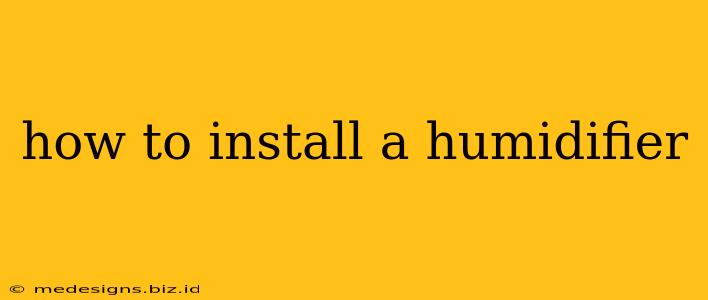Maintaining the right humidity levels in your home is crucial for your health and comfort. Dry air can lead to respiratory problems, dry skin, and even damage to your furniture. A humidifier combats these issues by adding moisture to the air. But before you can enjoy the benefits, you need to know how to install it correctly. This guide will walk you through the process, covering different types of humidifiers and offering helpful tips for optimal performance.
Choosing the Right Humidifier for Your Needs
Before installation, it's essential to select the appropriate humidifier for your space. There are several types available, each with its own installation requirements:
1. Evaporative Humidifiers:
These are generally the most affordable and easiest to maintain. They work by drawing water into a filter and evaporating it into the air. Installation typically involves simply plugging it into a power outlet and filling the water reservoir. Placement is key; avoid placing it near electronics or in areas with direct sunlight.
2. Ultrasonic Humidifiers:
Ultrasonic humidifiers use high-frequency vibrations to create a fine mist. They are quiet and energy-efficient but require regular cleaning to prevent mineral buildup. Installation is similar to evaporative humidifiers – simply plug it in and fill the reservoir. Consider the size of the room when selecting an ultrasonic humidifier to ensure adequate coverage.
3. Steam Humidifiers:
These humidifiers boil water to create steam, offering a powerful humidification solution. Installation is straightforward; however, caution is advised as they can be hot to the touch. Place them away from children and pets and on a stable, heat-resistant surface.
4. Whole-House Humidifiers:
These are professionally installed and integrated into your home's HVAC system. Installation requires the expertise of an HVAC technician and is significantly more involved than installing portable humidifiers. While more expensive upfront, whole-house humidifiers offer consistent and even humidification throughout your home.
Installing a Portable Humidifier (Evaporative or Ultrasonic): A Simple Guide
This section covers the installation of portable humidifiers, which are the most common type for home use.
Step 1: Choose the Right Location:
Select a location with good air circulation and away from direct heat sources (such as fireplaces, radiators, or direct sunlight). Avoid placing it near electronics to prevent damage from moisture.
Step 2: Prepare the Humidifier:
Carefully read the manufacturer's instructions. This will provide specific guidance for your model. Most often this involves filling the water reservoir with clean, fresh water (tap water is usually acceptable, unless otherwise specified).
Step 3: Plug in and Turn On:
Plug the humidifier into a grounded electrical outlet. Follow the manufacturer's instructions for turning the unit on and selecting the desired humidity level.
Step 4: Monitor and Maintain:
Regularly check the water level and refill as needed. Clean your humidifier according to the manufacturer's recommendations to prevent mineral buildup and bacteria growth. This will extend its lifespan and ensure optimal performance.
Troubleshooting Common Humidifier Issues:
- White Dust: This is often mineral buildup. Clean your humidifier regularly.
- Not Enough Moisture: Ensure you are using the correct humidifier for the room size and that the unit is properly functioning.
- Loud Noise: Check the water level and ensure the unit is properly positioned.
Optimizing Your Humidifier's Performance:
- Regular Cleaning: Clean your humidifier regularly to prevent mold and mildew.
- Water Quality: Use distilled water or filtered water if your tap water is hard to prevent mineral buildup.
- Proper Ventilation: Ensure proper ventilation in the room to prevent excessive humidity.
By following these steps and tips, you can easily install and maintain your humidifier, creating a healthier and more comfortable living environment for you and your family. Remember to always consult your humidifier's instruction manual for specific guidance.
